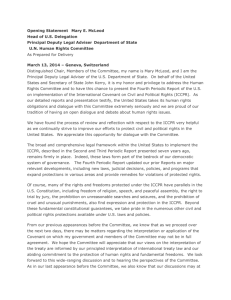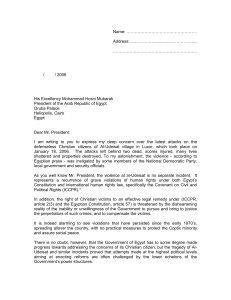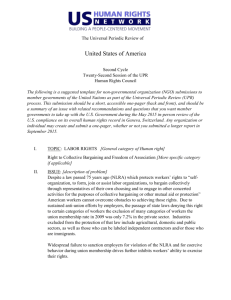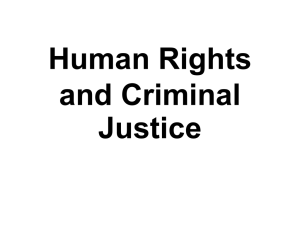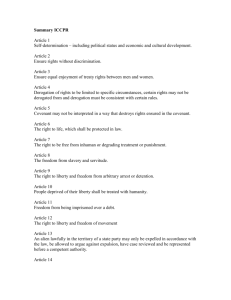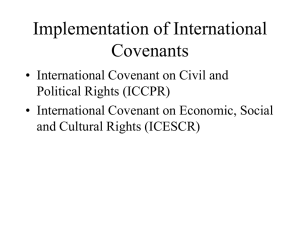“Impossible” Immigration Cases - Catholic Legal Immigration
advertisement
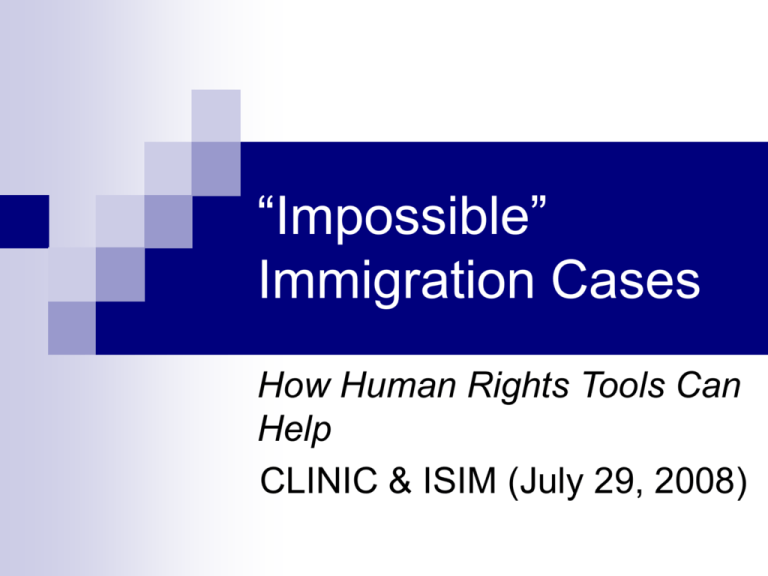
“Impossible” Immigration Cases How Human Rights Tools Can Help CLINIC & ISIM (July 29, 2008) Introductions/Warm-Up What do we do to help immigrant families? How have you used human rights tools? What do you think of these tools? [Add in here a more detailed overview of what the training will cover.] 2 What is the Human Rights Promoters Project? Joint project of Georgetown University Center for the Study of International Migration (ISIM) and Catholic Legal Immigration Network, Inc. (CLINIC) Directed by an Advisory Board consisting of CLINIC affiliate staff, human rights practitioners, and academics Supported by a generous grant from the U.S. Human Rights Fund 3 Objectives of the Human Rights Promoters Project To assist you to help your clients through bringing human rights norms to the attention of decision-makers and policymakers Help you participate in the international movement of human rights advocates 4 Methods of the Human Rights Promoters Project • • • • Human Rights Promoters Project: researches human rights norms designs practical human rights training designs tools to help you use human rights creates community of advocates using human rights to empower and assist immigrants 5 Why Use International Human Rights Law? It’s our role as lawyers and legal workers to develop the law for the benefit of our clients Human rights works! U.S. courts have begun to use this law to inform their decisions 6 [Add M. Ensor Human Rights Approach Slides here: below is KS summary] Beyond charity (moving from human needs) Adds clarity (establishes who rights holders and duty bearers are) Adds consistency and universality Lets advocates speak the same language across borders Establishes benchmarks and indicators of success Has the concept of remedies associated with it 7 Participating in the International Human Rights Movement Your contribution is vital! Many other sources, including: (1) Post-Deportation Human Rights Project at Boston College http://www.bc.edu/centers/humanrights/projects/de portation/resourcesat.html (2) Columbia University Center for the Study of Human Rights: http://hrcolumbia.org/ 8 Today’s Objectives Begin learning how to apply international human rights law to immigration advocacy: (1) For case representation (2) For non-litigation activities, such as reporting, testifying & organizing 9 Training’s Case Representation Focus Immigration cases where family ties play a role under U.S. statutes Where immigration officials or Immigration Judges exercise discretion Focus on how human rights laws and norms can inform discretionary decisions 10 Training’s Case Representation Focus (cont’d) Concentration on non-LPR cancellation, waivers We will use case examples We will not discuss litigating in international fora 11 [Insert new material here] Successful Australian case illustration --Discuss facts --Say what HR Cmte held --Give preview of U.S. court argument Insert Rex’s Flow Chart on building a legal argument here 12 What Is International Human Rights Law? International law generally governs rights of States (countries) vs. other States Ancient origin of protections of individual rights: agreements/procedures protecting travelers in foreign countries and on high seas “Humanitarian intervention” in 19th/early 20th centuries (some legitimate; some as a rationale for invading others’ territory) 13 What is International Human Rights Law (cont’d) World War II sparks modern development: -- punishment of Nazi and other war criminals: made it clear that individuals have obligations under inter’l law -- desire to prevent similar atrocities leads to establishment of U.N. and a series of inter’l human rights agreements 14 What is International Human Rights Law? (cont’d) US made major contribution to development of human rights law after World War II: -- Many U.S. lawyers participated in prosecution of Nazis/devel. individual responsibility theories -- Encouraged by Pres. Franklin Roosevelt’s “Four Freedoms” speech & support of United Nations -- Eleanor Roosevelt chaired commission that drafted Universal Declaration of Human Rights 15 Sources of Human Rights Law (Overview) Universal Declaration of Human Rights Treaties (or “Conventions”) Customary International Law 16 Universal Declaration of Human Rights Not a treaty – an authoritative interpretation or definition of rights under the United Nations Charter 17 Treaties or Conventions Treaty = an agreement governed by international law, usually between States or between States and international organizations Conventions/protocols are types of treaties Example of treaty to which U.S. has acceded: United Nations 1967 Protocol on the Status of Refugees = basis for Refugee Act of 1980 governing refugee and asylee status 18 What is the Effect of a Treaty in U.S. Law? Co-equal with a federal statute (later in time prevails) Superior to conflicting state law 19 When Does a Treaty Become Law in the United States? (1) (2) (3) (4) Executive signs Senate consent Consent deposited with treaty body Usually requires implementing legislation by Congress: Signing a Treaty does not generally make the Treaty enforceable in a U.S. Court unless Congress says it does 20 Issue of Implementing Legislation in United States U.S. Treaties almost always considered non-self-executing Non-self-executing treaties require implementing legislation unless Congress specifies otherwise Example: 1967 U.N. Refugee Protocol implemented by Refugee Act of 1980 21 Types of Treaties or Conventions Global or International Treaties: govern issues between a number of States (or States/Intergovernmental Organizations) --Example: 1967 Convention on the Status of Refugees --Includes Regional Treaties, such as the American Convention on Human Rights 22 Types of Treaties or Conventions (cont’d) Bilateral Treaties: Govern issues between two States, or between a State and an Intergovernmental Organization 23 Who Interprets Treaties? Treaty-established bodies: --Example: U.N. Human Rights Committee --Expand on fact that adjudicators are made by these treaties?? National governments: --through legislation --through jurisprudence 24 Interpretations of Right to Family Life: Adjudicators Whose Decisions We Will Discuss U.N. Human Rights Committee (interprets global agreement: International Convention on Civil and Political Rights) European Court of Human Rights (interprets regional agreement: European Convention on Human Rights) 25 Nature of these Adjudicators Their decisions not binding on U.S. Their decisions are persuasive guidance about U.S. obligations on “the right to respect for family life” under U.S. law 26 Human Rights Adjudicator # 1 U.N. Human Rights Committee -- 18 members -- Sits in Geneva and New York -- Adjudicates cases under the International Convention on Civil and Political Rights (“ICCPR”) = global Convention -- Arts. 17, 23 of ICCPR = Right to Respect for Family Life 27 Add one slide here on how to get to U.N. Committee (adherence, exhaustion of domestic remedies, etc.) – or include this in outline or introductory memo instead. 28 Human Rights Adjudicator # 2 European Court of Human Rights -- 49-member body --Sits in Strasbourg, France 29 European Court of Human Rights (con’t) --Adjudicates cases under the European Convention on Human Rights (regional Convention) --Art. 8 of European Convention = Right to Respect for Family Life 30 Add one slide here about how to get to the European Court (adherence, exhaustion of domestic remedies, etc. – or put this in outline or in introductory memo). 31 Decisions by Treaty-Established Bodies (1) (2) Only binding if the State party agrees to be bound (U.S. does not agree to be bound by Treaty bodies) Decisions of these bodies may be persuasive interpretations of the Treaty or Convention even for States that have not agreed to be bound 32 Customary International Law “Practices and beliefs that are so vital and intrinsic a part of a social and economic system that they are treated as if they were laws.” – Black’s Law Dictionary 162 (17th ed. 1996) 33 Customary International Law and Human Rights Includes “a consistent pattern of gross violations of internationally recognized human rights” Very limited scope: Probably only genocide, torture, slavery, prolonged arbitrary detention 34 Using Human Rights in a U.S. Setting (#1): Treaties the U.S. Has Joined Interpret based on: (1) U.S. implementing legislation (2) U.S. jurisprudence (decisions of federal and state courts; other adjudicators) (3) Jurisprudence of global or regional bodies (as persuasive authority; not binding) 35 Using Human Rights in a U.S. Setting (#1): Treaties the U.S. Has Joined (cont’d) (3) Jurisprudence of other nations (also not binding) (4) Analogize from interpretations of similar language in other treaties that the U.S. has not joined --Example: U.N. Human Rights Committee uses European Court decisions by analogy 36 Enforcing U.S.-Ratified Treaties in Domestic Courts Supremacy Clause Self-executing vs. Non-self-executing treaties 37 Self-Executing vs. Non-SelfExecuting (“NSE”) Treaties Original Foster v. Neilson definition Self-executing treaties can be directly enforced by the courts Treaties that are not self-executing (“NSE”) require implementing legislation to be judicially enforced But treaties have been designated NSE for different reasons: 38 Two interpretations What it means when a treaty is NSE 1. The treaty is not judicially enforceable 2. The treaty does not create a private cause of action 39 Interpreting the ICCPR’s NSE declaration (1) “…articles 1 through 27 of the Covenant are not self-executing” Interpretation by lower courts: ICCPRbased claims denied because… 1. The claimant “lacks standing;” 2. The treaty is “not judicially enforceable;” or 3. The treaty does not create privately enforceable rights, or is not the law of the land. 40 Interpreting the ICCPR’s NSE declaration (2) Empirically the case law shows 1. No judicial consensus 2. Courts often confuse different possible meanings of non-self-execution or use them interchangeably within the same opinion 41 Interpreting the ICCPR’s NSE declaration (3) Legislative history as interpretive guide “…the Covenant will not create a private cause of action in U.S. courts” “…existing U.S. law generally complies with the Covenant; hence, implementing legislation is not contemplated.” Non-frivolous argument that provisions of the Covenant can be raised defensively 42 Treaties and Statutory Construction Charming Betsy canon of statutory construction Last-in-time rule requires clear legislative intent to supersede provisions of a ratified treaty 43 Using Human Rights in a U.S. Setting (#2): Treaties the U.S. Has Not Joined By analogy on language: to interpret similar language in domestic law --Example: “Best interests of the child” By analogy on subject matter: to show growing international consensus on a particular issue --Example: Conv. on the Rights of the Child 44 BREAK 45 [Add new slide here – Rex’s diagram of arguments – as transition/explanation of the legal analysis that follows] Stress: this is merely one example of how hr law can be used – we chose it bec it’s at the core of your work and it’s a good starting point Rex: “This may be the first time you’ve thought about family life = a right.” 46 Right to Respect for Family Life Objectives of this section: To use human rights concept of “right to respect for family life” in litigation, documentation, testimony, and other advocacy 47 Right to Respect for Family Life Litigation objective: Be able to argue how U.S. obligations to implement “right to respect for family life” should inform Immigration Judge and CIS discretionary decisions on: --Exceptional and extremely unusual hardship or extreme hardship --In cancellation, waiver applications 48 What Is the Right to Respect for Family Life? “The family is the natural and fundamental group unit of society and is entitled to protection by society and the state.” -Universal Declaration of Human Rights, Art. 16(3) 49 What Is the Right to Respect for Family Life? (cont’d) Right also is explicitly recognized in numerous international human rights agreements, including: --Inter’l Convention on Civil and Political Rights, Arts. 17, 23 (global) Give URL for treaty here? --Inter’l Convention on Economic, Social & Cultural Rights, Art. 10(1) (global) --Convention on the Rights of the Child, Preamble (global) --European Convention on Human Rights, Art. 8 (regional) Give URL for treaty here? --American Convention on Human Rights, Art. 17 (regional) 50 Who Are Protected Individuals? Decision-makers’ approach is flexible and fact-based --Focus on strength of actual emotional ties between family members --Some other ties also important (such as economic dependence) 51 Who Are Protected Individuals? In case decisions, close family predominates: --Parent-child (particularly if child born in wedlock) --Parent-adult child (if economic or other dependence) --Maybe other blood relatives if very close (grandparents) 52 [Transition] Say here that we are now moving from the concepts of right to respect for family life into INTERPRETATION, first by Human Rights Committee and then by European Court. 53 Family Life Cases Decided Under ICCPR U.N. Human Rights Committee decides cases under Arts. 17 and 23 of the ICCPR Terms of ICCPR are binding on U.S. HR Committee decisions not binding on U.S. adjudicators, but should be considered persuasive in determining U.S. obligations 54 “Right to Family Life” in ICCPR ICCPR (Art. 17) “1. No one shall be subjected to arbitrary or unlawful interference with his privacy, family, home or correspondence … “2. Everyone has the right to the protection of the law against such interference …” ICCPR (Art. 23) “1. The family is the natural and fundamental group unit of society and is entitled to protection by society and the State.” Compare European Convention 55 Human Rights Committee Analysis of Right to Respect for Family Life (1) Does family life exist? (2) Is the State’s act an “interference”? (Committee usually decides “yes”) If so: (3) Was the interference “arbitrary”? 56 HR Committee Negative-Duty (Removal) Cases Winata v. Australia (2001) --Indonesian overstay parents; 14 years’ residence in Australia --13-yr-old Australian son: schooling all in Australia; no cultural ties to Indonesia --Committee balances equities and holds that removal would violate family’s right to family life under ICCPR 57 HR Committee Negative Duty (Removal) Cases Madaferri v. Australia (2004) --Italian w/several minor convictions in Italy overstays tourist visa; marries and has 4 children in Australia; they live together 14 years --Children have no cultural or linguistic ties to Italy --Father denied spousal visa due to crimes --Committee balances equities; holds for petitioner saying State interest weak given age of crimes; crimes outside of Australia, children’s lack of cultural or linguistic ties to Italy 58 European Court of Human Rights Add a line of transition and some additional explanation here?? Q: Why discuss Eur. Ct. cases when European Convention does not apply to U.S.? A: U.N. Human Rights Committee finds Eur. Ct. interpretation of Art. 8 of European Convention persuasive when H.R. Committee interprets the similar provisions in Arts. 17 and 23 of ICCPR. ICCPR does apply to the U.S. 59 European Convention Art. 8 “(1) Everyone has the right to respect for his private and family life . . . “(2) There shall be no interference by a public authority with the exercise of this right except such as is in accordance with the law and is necessary in a democratic society.” 60 European Court Analysis of Right to Respect for Family Life (1) (2) (3) Does family life exist? Is State action an “interference”? (in these cases, European Court almost always concludes that it is) Note possibly – here and/or above – that right doesn’t ONLY apply to immigration cases 61 European Court Analysis of Right to Respect for Family Life (cont’d) (3) [Balancing test]: Was government action justified as: --in accordance with law? --necessary in a democratic society? --in the interests of such concerns as national security or public safety? 62 European Court Case Decisions Right to respect for family life more readily found by European Court in “negative duty” (removal) cases than in “positive duty” (admission/or exclusion??) cases 63 European Court: Negative Duty (Removal) Cases Berrehab v. Netherlands (1988) --long-time resident of Netherlands; divorced from Dutch wife --long-resident in Netherlands; denied renewal of residence permit after divorce --removal to Morocco would separate him from daughter 64 European Court: Negative Duty (Removal) Cases (cont’d) Berrehab v. Netherlands (cont’d) Court holds for petitioner, finding: (1) Family life exists (2) Deportation would interfere with family life (3) Action was in accordance with law and met legitimate aim (protecting labor market), but not necessary in a democratic society 65 European Court: Positive Duty (Admission) Cases Abdulaziz v. U.K. (1985) --immigrants granted residence while single; when they married, their husbands were denied entry Court holds against petitioners, finding: (1) Family life existed, but it was established after petitioners immigrated 66 European Court: Positive Duty (Admission) Cases (cont’d) Abdulaziz v. U.K. (1985) (cont’d) (2) When they married, petitioners knew husbands could be denied admission; (3) Art. 8 does not protect the right to choose residency, when it means requiring State to accept new residents; (4) No real obstacle to petitioners and their husbands settling in their home countries 67 [Summary:] Right to Respect for Family Life: Balancing the Equities Decision-makers find “family life” exists when actual relationship close (but not well-tested outside parent-child framework) Decision-makers generally find that domestic immigration enforcement actions interfere with right to family life 68 Right to Respect for Family Life: Balancing the Equities (cont’d) Most important balancing factor is whether State’s interference in petitioner’s family life is justified and proportionate to State’s interest 69 [ Transition] [And now we’ll talk about using it in the U.S.] 70 ICCPR Right to Family Life: Enforcing it in U.S. Immigration Cases Objective: To encourage IJs and USCIS to use ICCPR to inform their decision-making for cases where: (1) Benefit rests on a family relationship, and (2) Decisions are at least partly discretionary --Examples: cancellation; certain waivers 71 ICCPR Right to Family Life: Enforcing it in Immigration Cases (cont’d) In this section, we will cover applying ICCPR to: (1) Non-LPR Cancellation of Removal (2) 212(i) waiver (3) 212(h) waiver 72 Non-LPR Cancellation of Removal: Statutory Requirements Cancellation of Removal: INA 240A(b) (1) 10 years’ physical presence (2) Good moral character for 10 years (3) Removal would result in exceptional and extremely unusual hardship to spouse, parent, or child, who is a United States citizen or lawful permanent resident --This hardship test is focus of our ICCPR analysis 73 Cancellation: BIA Has Set Very Stringent Hardship Standard Matter of Recinas (BIA 2002): Exceptional/ extremely unusual hardship found where: -- Respondent (R) has 4 USC children & 2 other children; children raised in U.S.; know little Spanish -- Children entirely dependent upon mother who runs her own business (father absent and being deported) -- No close family in Mex. (R’s parents are LPRs in US, 5 siblings are USCs). R and children close to U.S. family -- R has 14 years’ residence in U.S. and little hope to immigrate if removed 74 Cancellation: ICCPR Argument (Summary) (1) (2) (3) Hardship determination must be made according to all U.S. law, including treaties ICCPR requires a full and reasonable balancing test for hardship Once balancing test in place, IJ decision should be informed by H.R. Committee decisions under ICCPR (and also decisions under analogous treaties, such as European Court cases under European Convention) 75 (1) (2) [Comment from July training: the distinction between direct and indirect challenge needs to be made clearer here in the following four slides. Maybe do a graphic depiction side-by-side of two arguments] “We’ll now talk about direct and indirect challenges.” Direct: Say here that “the purpose of the direct challenge is to prove that the exceptional and extremely unusual standard violates U.S. law because treaty law is part of U.S. law” Indirect: Say here that “indirect challenge asserts that the extreme/exceptional standard should be implemented in accordance with inter’l law Then walk through argument both direct and indirect. Use graphic. Use same process when discussing waivers. 76 Cancellation: ICCPR Argument: “Direct” Challenge to Statute (A) U.S. is a party to the ICCPR (entered into force 1992) (B) Congress is presumed to have legislated in a manner consistent with international law --Argue: Cancellation law enacted later in time (1996) does not repeal ICCPR norm because no clear intent to do so in the 1996 statute --Courts must construe statute not to conflict with treaty where it’s possible to do so Mention Charming Betsey here 77 Cancellation: ICCPR Argument: “Direct” Challenge (cont’d) (C) DIRECT CHALLENGE: (1) Conflict between ICCPR and cancellation hardship standard can’t be reconciled, because -- U.S. law assumes State’s interest; does not balance with petitioner’s interest as ICCPR requires; or -- BIA does implicitly balance equities, but applicant must meet a far higher cumulative standard than permitted under ICCPR; therefore, (2) Cancellation statute is unlawful under ICCPR and cannot be enforced 78 Cancellation: ICCPR Argument: “Indirect” Challenge to Statute (A) U.S. is a party to the ICCPR (entered into force 1992) (B) Congress is presumed to have legislated in a manner consistent with international law --Argue: Cancellation law enacted later in time (1996) does not repeal ICCPR norm because no clear intent to do so --Courts must construe statute not to conflict with treaty where it’s possible to do so 79 Cancellation: ICCPR Argument: “Indirect” Challenge to Statute (cont’d) (C) INDIRECT CHALLENGE: Decisionmakers should reconcile Cancellation statute to conform to ICCPR obligations by performing a full balancing of individual’s/family’s interest in member remaining vs. U.S. government’s interest in member being deported 80 What Should IJ Ask When Analyzing Cancellation Under Arts. 17 & 23 of ICCPR? (1) Has applicant shown family life? -- Spouse, parent, child -- (Maybe others?) (2) Do relatives have status in the U.S.? -- USC or LPR -- (Maybe other status?) 81 What Should IJ Ask When Analyzing Cancellation Under Art. 17 of ICCPR? (cont’d) (3) Hardship Analysis: Do interests of noncitizen in remaining outweigh interests of U.S. gov’t in deporting? -- Under ICCPR, standard cannot be so high that a single or a few negative factors outweigh a stronger showing of positives -- Use Winata, Madaferri (and other similar) cases to inform this discretionary decision 82 Cancellation and ICCPR: Small Group Exercise 83 WAIVERS [See slide # 77 on introducing direct and indirect challenges. Use graphic.] Assume that the 212(i) and 212(h) waivers here will be substituted with other waivers identified by the project as being more promising 84 212(i) Waiver 212(i) waives fraud or misrepresentation under INA section 212(a)(6)(C)(i): -- “Any alien who, by fraud or willfully misrepresenting a material fact, seeks to procure (or has sought to procure or has procured) a visa, other documentation, or admission into the United States or other benefit under this Act is inadmissible.” 85 212(i) Waiver (cont’d) Waiver requires showing of “extreme hardship” to: -- U.S. citizen or LPR spouse or parent -- (Hardship to child does not count) (Person who would suffer hardship need not be the petitioner) USCIS (or IJ) has discretion to decide whether required hardship is shown 86 “Extreme Hardship” BIA interpretation of factors included in “extreme hardship” determination: Matter of Anderson, 16 I. & N. Dec. 596 (1978) (1) Noncitizen’s age (2) Length of residence in the U.S. (3) Family members in U.S. and abroad; their immigration or citizenship status 87 “Extreme Hardship” (cont’d) Matter of Anderson factors (cont’d): (4) Health, and is there medical care in home country (5) Financial impact of departure from U.S. (6) Other possible means of immigrating (7) History of immigration violations (8) Position in community (9) Economic/political factors in home country 88 “Extreme Hardship” (cont’d) Matter of Anderson factors (cont’d): (10) Linguistic/cultural factors that make getting work difficult in home country (11) Other factors re: home country (12) Any other factors in U.S. or abroad 89 212(i) Waiver: ICCPR Model Challenge: (Direct Challenge) Example: situation where hardship is to child (not spouse or parent) (1) The U.S. has joined the ICCPR. Art. 17 recognizes the right to respect for family life (2) Congress is presumed to have legislated in a manner consistent with international law 90 212(i) Waiver: ICCPR Model Challenge: (Direct Challenge) (cont’d) (3) Applicant has established family life in the U.S. with his USC daughter (4) Government interference with applicant’s right to family life cannot be arbitrary under ICCPR Art. 17 (5) Statute is arbitrary on its face because it does not provide an opportunity for decision-maker to consider hardship to applicant’s daughter 91 212(i) Waiver: ICCPR Model Challenge: (Direct Challenge) (cont’d) (6) 212(i) statute is therefore unlawful under ICCPR Art. 17. (7) To cure this problem, U.S. CIS must consider the waiver application (see Beharry v. Reno, 183 F. Supp. 2d 584, 595 (E.D.N.Y. 2002)) and balance: -- hardships to applicant’s USC daughter if waiver not granted, vs. -- government’s interest in denying the waiver 92 212(i) Waiver: ICCPR Model Challenge: (Direct Challenge) (cont’d) (8) Under ICCPR, standard applied to applicant cannot be so high that a single or a few negative factors outweigh positive factors (9) Use Human Rights Committee cases or other decisions to inform decision (10) Note, however, important cautions! (Consult before filing a direct challenge!) --Non-self-executing issue --Last-in-time issue 93 212(h) Waiver Waiver under INA Section 212(h): Waives: (1) Crime of moral turpitude (2) Multiple criminal convictions (3) Single offense of simple possession of 30 grams or less of marijuana (4) Prostitution and commercialized vice 94 212(h) Waiver (cont’d) 212(h) does not waive: -- Controlled substance violations, except one offense of simple possession of 30 grams or less of marijuana, NOR -- Trafficking in controlled substance or persons, NOR -- Murder or torture 95 212(h) Waiver (cont’d) (1) (2) (3) Our focus: waiver under 212(h)(1)(B): alien is spouse, parent, son, or daughter of USC or LPR extreme hardship would result to USC or LPR spouse, parent, son, or daughter if waiver not granted U.S.CIS (or IJ) has discretion to determine eligibility for waiver, including whether hardship shown 96 212(h) Waiver: ICCPR Model Challenge: (Direct Challenge) Example: Situation where applicant for waiver has USC wife and son, but 2 marijuana simple possession convictions (1) The U.S. has joined the ICCPR. Art. 17 recognizes the right to respect for family life (2) Congress is presumed to have legislated in a manner consistent with international law 97 212(h) Waiver: ICCPR Model Challenge: (Direct Challenge) (cont’d) (3) Applicant has established family life in the U.S. with his USC son and wife (4) Government interference with applicant’s right to family life cannot be arbitrary under ICCPR Art. 17 (5) Statute is arbitrary on its face because it does not provide an opportunity for decision-maker to consider hardship to applicant’s son and wife if he cannot immigrate (because he has more than 1 simple possession conviction) 98 212(h) Waiver: ICCPR Model Challenge: (Direct Challenge) (cont’d) (6) 212(h) statute is therefore unlawful under ICCPR Art. 17. (7) To cure this problem, U.S. CIS must consider the waiver application (see Beharry v. Reno at p. 595) and balance all equities, including: -- hardships to applicant’s USC son and wife if waiver not granted and he can’t immigrate, and -- age of crimes and seriousness of crimes, vs. -- government’s interest in preventing applicant from immigrating 99 212(h) Waiver: ICCPR Model Challenge: (Direct Challenge) (cont’d) (7) Under ICCPR, standard applied to applicant cannot be so high that a single or a few negative factors outweigh positive factors (8) U.S. CIS should use Human Rights Committee and similar decisions when analyzing applicant’s situation (9) Note, however, important cautions! (Consult before filing a direct challenge!) --Non-self-executing issue --Last-in-time issue 100 Waivers and ICCPR: Small-Group Exercise 101 Conclusion on Litigation: Open Issues Many open issues, including: -- Can you challenge under ICCPR when applicant does not have child/spouse/ parent who would be affected? -- What if child/spouse/parent is asylee or has deferral of removal (some other “indefinite” status) instead of LPR or USC status? --SIGNIFICANT direct challenge issues described above (non-self-executing; last-in-time) 102 Conclusion on Litigation: Pointers Consult with others: is this the right case? Preserve these legal issues at the CIS application or IJ level for appeal Prepare and brief carefully Consider enlisting help on appeals Share your results with others so we can all learn together 103 [Note: current thought (Aug. 08) is to eliminate non-litigation advocacy piece from this training – the following slides are those from the July 2008 training on these topics in case it’s included] 104 Human Rights Law and NonLitigation Advocacy Documenting/Reporting/Community organizing: --Example: Border Network for Human Rights: A Testimonial Report: The Status of Human and Civil Rights at the Border 2007 (Dec. 2007) 105 Human Rights Law and NonLitigation Advocacy (cont’d) Testimony before local, state, or federal government entities “Shadow reports” to inter’l bodies Community meetings/rights presentations Press work Grant proposals Other: _______________ 106 Human Rights Law and NonLitigation Advocacy (cont’d) Gonzalez family exercise 107 Ideas for Future Collaboration 108 Training Evaluation 109
